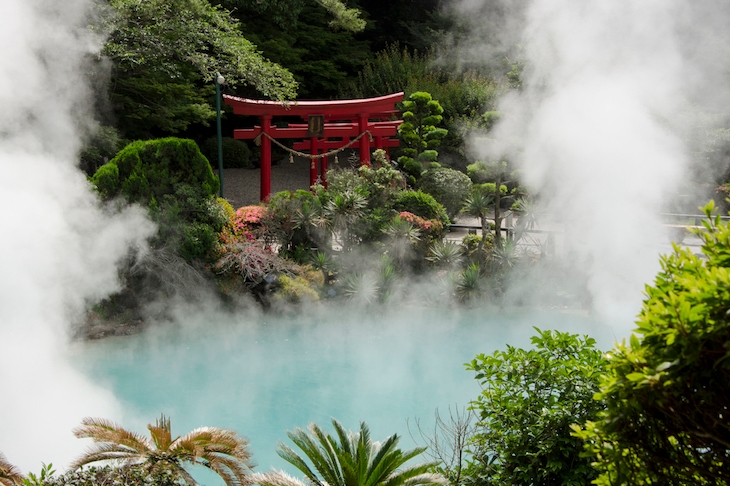‘I was last night sent officially to witness the execution by harakiri (self-immolation through disembowelling) of Taki Zensaburo… As the harakiri is one of the customs of this country which has excited the greatest curiosity in Europe… I will tell you what occurred…’
In The Spanish Ambassador’s Suitcase, my anthology of dispatches from British diplomats abroad, this one, dating from 1868, is the oldest. The first eye-witness account of harakiri ever given by a European, it’s also the most grisly. I cannot match the horror or novelty, nor can I match its author, Bertie Mitford, in fine writing. But having just returned from my first visit to Japan, I thought to offer you a three-ha’penny postscript to Mitford’s fifty-guinea prose: on a practice infinitely less shocking, yet in its way as strangely ceremonious.
Travelling independently in Japan for ten days, mostly outside the cities, we fast became aware of the Japanese near-obsessive delight in washing, and their particular love for natural thermal baths. They call a hot spring an onsen, and wherever one occurs (there are thousands) you will find, clustered around the accidental geothermal leak like temples around the site of a miracle, the human infrastructure of leisure, pleasure and the rituals of bodily hygiene. There will be reception rooms, changing rooms, lockers, showers and loos, all leading up to two shallow indoor or outside pools: one for men and one for women, separated by screens, bamboo, or (in one case) a lifesize model elephant.
But our favourite was at the Iya Onsen Hotel. The Iya Valley — the course of a long, deep-set mountain river — nestles among mountains of almost Disneyesque steepness on the huge island of Shikoku. Except for its narrow coastal strip, Shikoku is nearly all densely cloud-forested green mountain, usually too steep for human habitation and often too steep for roads or even paths. Think Machu Picchu for a sense of scale and gradient. The mountains hang from the rainy skies like thick green curtains.
There is a narrow single-track road up the Iya valley, high above the river. Tiny settlements cling to the roadside, many depopulated. In one, a Japanese artist who had returned to find the village of her girlhood deserted, has made it the work of her later years to knit and stuff hundreds of lifesize human dolls. These are to be found sitting outside abandoned houses, or in rooms within, or by the roadside, in shops or up ladders, in vegetable patches or (in Day-Glo jackets and helmets) up telephone poles: one woman’s creepy lament for a vanishing past.
At the top of the road is the Iya hotel, long-established and quietly well-to-do, sitting high above the river. The thermal spring is 600ft below, by the river, through a wilderness impossible to access on foot. So in the last century they built a funicular railway from hotel to spring. Guests drive the car by pressing buttons on a dashboard to alert the attendant at the top, who bows as you board, and again as you alight.
We learned the form. In your elegantly minimalist hotel bedroom (no shoes, bed a futon on the floor) you don a dressing gown and slippers, keeping your pants on for the moment and taking a dishcloth-sized white towel. You present yourself to the funicular attendant, who has trained wild birds to feed from his (and your) hand. You board the funicular, press the Go button, and begin a stately descent down the mountainside. A looped tape plays Debussy’s Clair de Lune. After about five minutes you step out on to a wooden platform just above the river.
Gentlemen then pass through a blue curtain, and ladies through a red one, carrying their tiny towels. It is made plain to both sexes that they must next divest themselves completely. Naked, you now enter the shower area and are expected to wash yourself very thoroughly. Japanese bathers, I noted, perform not one but two soapings and rinsings.
You are then ready for the pool beside your undressing room. You take your little towel but do not wear it: it’s not a loin-cloth. The pools at Iya are about 10ft in diameter, lined with smooth pebbles set in concrete and deep enough to sit up to your chest in water. You’re virtually outdoors, separated from the ladies’ pool by a rush screen.
The water gushes at bath temperature from a big pipe, and exits over a sluice and into the river. It smells of sulphur and is cloudy with a white mineral that coats your skin with a silkiness. Already in the water will very likely be a handful of Japanese men, young and old, some — inexplicably — with their little towels folded on their heads. Some chat quietly. Others are silent. Nobody splashes around: the atmosphere is meditative. You can look over the sides of the enclosure, open to the river rushing by and to the mountainside above. The ambience is not sexually charged but you notice that, contrary to male western myth, Japanese men are no worse (or better) endowed than we are.
You stay immersed for at least half an hour, which passes fast. Leaving, you nod to others; don dressing gown and slippers; sip a beer from the vending machine; then call the funicular. The point of the white towel remains unclear. At meal times other diners will still be in dressing gowns.
I ascended alone in the funicular. It was raining, and curling wisps of white cloud clung to the mountainside. Delicately foliaged trees, leaves like tiny stars, were turning autumnal red. Boughs hung in the mist. Nature looked stylised. I realised that the Japanese artistic sensibility is not a prism through which they see their world. We see their world as they do: it is how nature looks, in Japan.
At the top, the attendant bowed and offered some seed for the wild birds. I found myself bowing back.







Comments